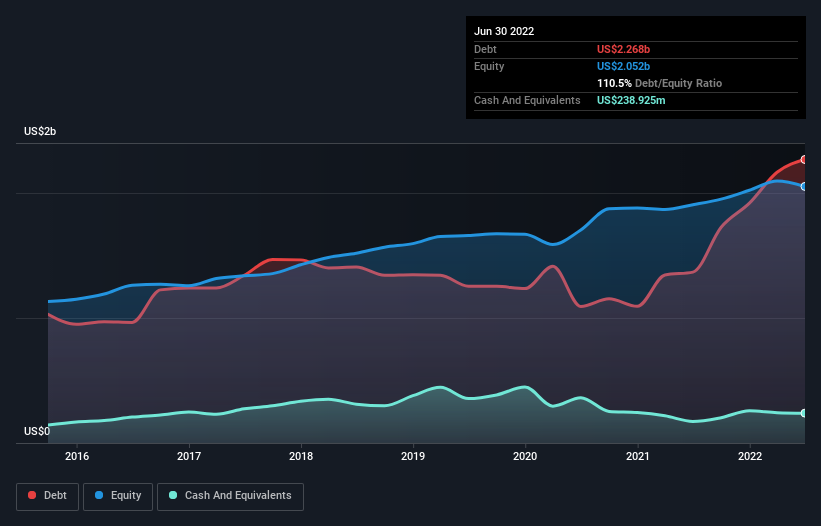- United States
- /
- Logistics
- /
- NasdaqGS:CHRW
Here's Why C.H. Robinson Worldwide (NASDAQ:CHRW) Can Manage Its Debt Responsibly

Some say volatility, rather than debt, is the best way to think about risk as an investor, but Warren Buffett famously said that 'Volatility is far from synonymous with risk.' It's only natural to consider a company's balance sheet when you examine how risky it is, since debt is often involved when a business collapses. We note that C.H. Robinson Worldwide, Inc. (NASDAQ:CHRW) does have debt on its balance sheet. But the real question is whether this debt is making the company risky.
Why Does Debt Bring Risk?
Debt assists a business until the business has trouble paying it off, either with new capital or with free cash flow. In the worst case scenario, a company can go bankrupt if it cannot pay its creditors. However, a more frequent (but still costly) occurrence is where a company must issue shares at bargain-basement prices, permanently diluting shareholders, just to shore up its balance sheet. Of course, debt can be an important tool in businesses, particularly capital heavy businesses. When we examine debt levels, we first consider both cash and debt levels, together.
View our latest analysis for C.H. Robinson Worldwide
How Much Debt Does C.H. Robinson Worldwide Carry?
The image below, which you can click on for greater detail, shows that at June 2022 C.H. Robinson Worldwide had debt of US$2.27b, up from US$1.37b in one year. However, because it has a cash reserve of US$238.9m, its net debt is less, at about US$2.03b.

How Healthy Is C.H. Robinson Worldwide's Balance Sheet?
According to the last reported balance sheet, C.H. Robinson Worldwide had liabilities of US$3.49b due within 12 months, and liabilities of US$1.92b due beyond 12 months. Offsetting this, it had US$238.9m in cash and US$4.82b in receivables that were due within 12 months. So its liabilities total US$345.0m more than the combination of its cash and short-term receivables.
Of course, C.H. Robinson Worldwide has a titanic market capitalization of US$13.1b, so these liabilities are probably manageable. However, we do think it is worth keeping an eye on its balance sheet strength, as it may change over time.
We measure a company's debt load relative to its earnings power by looking at its net debt divided by its earnings before interest, tax, depreciation, and amortization (EBITDA) and by calculating how easily its earnings before interest and tax (EBIT) cover its interest expense (interest cover). This way, we consider both the absolute quantum of the debt, as well as the interest rates paid on it.
C.H. Robinson Worldwide has a low net debt to EBITDA ratio of only 1.4. And its EBIT covers its interest expense a whopping 22.8 times over. So you could argue it is no more threatened by its debt than an elephant is by a mouse. On top of that, C.H. Robinson Worldwide grew its EBIT by 65% over the last twelve months, and that growth will make it easier to handle its debt. When analysing debt levels, the balance sheet is the obvious place to start. But it is future earnings, more than anything, that will determine C.H. Robinson Worldwide's ability to maintain a healthy balance sheet going forward. So if you're focused on the future you can check out this free report showing analyst profit forecasts.
But our final consideration is also important, because a company cannot pay debt with paper profits; it needs cold hard cash. So we always check how much of that EBIT is translated into free cash flow. In the last three years, C.H. Robinson Worldwide's free cash flow amounted to 34% of its EBIT, less than we'd expect. That weak cash conversion makes it more difficult to handle indebtedness.
Our View
Happily, C.H. Robinson Worldwide's impressive interest cover implies it has the upper hand on its debt. But, on a more sombre note, we are a little concerned by its conversion of EBIT to free cash flow. Looking at the bigger picture, we think C.H. Robinson Worldwide's use of debt seems quite reasonable and we're not concerned about it. While debt does bring risk, when used wisely it can also bring a higher return on equity. There's no doubt that we learn most about debt from the balance sheet. However, not all investment risk resides within the balance sheet - far from it. Case in point: We've spotted 5 warning signs for C.H. Robinson Worldwide you should be aware of, and 3 of them make us uncomfortable.
If, after all that, you're more interested in a fast growing company with a rock-solid balance sheet, then check out our list of net cash growth stocks without delay.
New: AI Stock Screener & Alerts
Our new AI Stock Screener scans the market every day to uncover opportunities.
• Dividend Powerhouses (3%+ Yield)
• Undervalued Small Caps with Insider Buying
• High growth Tech and AI Companies
Or build your own from over 50 metrics.
Have feedback on this article? Concerned about the content? Get in touch with us directly. Alternatively, email editorial-team (at) simplywallst.com.
This article by Simply Wall St is general in nature. We provide commentary based on historical data and analyst forecasts only using an unbiased methodology and our articles are not intended to be financial advice. It does not constitute a recommendation to buy or sell any stock, and does not take account of your objectives, or your financial situation. We aim to bring you long-term focused analysis driven by fundamental data. Note that our analysis may not factor in the latest price-sensitive company announcements or qualitative material. Simply Wall St has no position in any stocks mentioned.
About NasdaqGS:CHRW
C.H. Robinson Worldwide
Provides freight transportation and related logistics and supply chain services in the United States and internationally.
Solid track record with excellent balance sheet and pays a dividend.
Market Insights
Community Narratives



